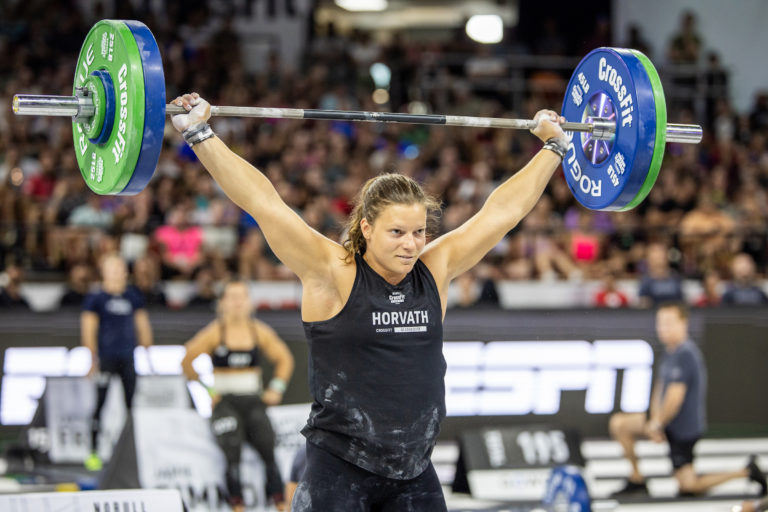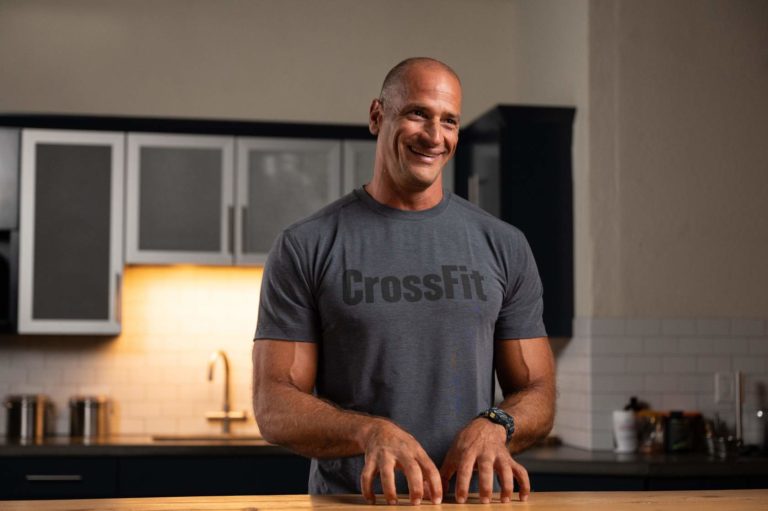Sports fans and fitness enthusiasts couldn’t ask for a better summer. With the Olympics in Paris overlapping with the CrossFit Games in Fort Worth, many of us will be glued to our screens, bouncing back and forth between coverage of these two great events. It is awe-inspiring to see the incredible feats these athletes are capable of and witness them pushing the limits of human capacity.
As CrossFit athletes, we can relate very well to some of the Olympic events. We’ve all snatched, sprinted, and swam. So, we have a general idea of how incredible it is for a man to snatch close to 500 lb and a woman to snatch over 300 lb, for someone to run 400 meters in 44 seconds, 800 meters in under 1 minute and 45 seconds, and for a woman to swim a half mile in just over 8 minutes.
The men’s decathlon (10 events) and women’s heptathlon (seven events) always capture our imagination as these athletes show their prowess in so many events as they vie for the title of “World’s Greatest Athlete.” Meanwhile, at the CrossFit Games, the athletes demonstrate incredible technique, with weights we can’t even imagine using, at speeds that boggle the mind. They’ll do this for multiple workouts every day, covering a wide range of fitness capacities from short and intense to long and grueling in the hopes of being crowned “Fittest on Earth.”
Many viewers might not distinguish between “greatest athlete” and “fittest athlete.” According to Google’s AI overview: “Decathletes often receive the title of ‘World’s Greatest Athlete’ because the decathlon is considered the only objective test of all-around athletic ability. The decathlon is a 10-event athletic contest with running, jumping, throwing, and other track and field events. Decathletes must demonstrate strength, endurance, agility, speed, stamina, and mental and emotional acuity.” Reading this, those unfamiliar with CrossFit’s definition of fitness may also think a decathlete could win the CrossFit Games.
This is not the case.
CrossFit defines fitness as work capacity across broad time and modal domains. This means CrossFit athletes strive to accomplish high levels of work across all different time domains (from seconds to hours), with any task or combination of tasks asked of them at any moment. Decathletes are incredibly gifted and very fit, too. However, the nature of their 10-event competition, which dictates their training, results in a narrower fitness that inevitably has deficiencies in areas that would be exposed at the CrossFit Games.
To contrast the difference in the fitness required of an Olympic decathlete and a CrossFit Games competitor, we can start by comparing each competition. The decathlon consists of 10 track-and-field events over two days. The events are:
- 100-meter run
- Long jump
- Shot put
- High jump
- 400-meter run
- 110-meter hurdles
- Discus throw
- Pole vault
- Javelin
- 1,500-meter run
These events are very anaerobic and heavily biased toward power and speed. The modalities tested are running, jumping, and throwing. The longest event is the 1,500-meter run, which lasts about 4-and-a-half minutes. Eight of the 10 events comprise repeated all-out efforts, each lasting less than 15 seconds with significant rest in between. So, while there may be numerous events, the actual breadth of the capacity tested is not that broad.

Laura Horvath, 2023 CrossFit Games
By contrast, of the 12-15 events that regularly make up the CrossFit Games, some will last just a few seconds (e.g.,, max snatch), while some may exceed two hours (e.g., marathon row). You will see a variety of movement modalities (weightlifting, gymnastics, running, biking, swimming, rowing, etc.) and functions (squatting, pushing, pulling, etc.) programmed at differing levels of complexity using a wide variety of equipment. Loads vary from maximum loads (max deadlift) to workouts that involve just body weight. Athletes are subjected to a nearly infinite variety of rep ranges, set schemes, and overall volumes throughout the week. Finally, as an added element of difficulty, the events are not pre-set each year, and many of the events are announced on the day of the contest. Occasionally, athletes don’t know the event until moments before they start. This ability to handle the “unknown and unknowable” is a critical adaptation from CrossFit.
From this comparison, it’s clear the CrossFit Games require a much broader level of fitness than their competitors. To give credit where credit is due, however, the decathlon itself doesn’t tell the whole story about decathletes’ capacity. Imagine if one of these athletes told us they wanted to add the title of Fittest on Earth to their World’s Greatest Athlete medal and asked us to train them. What skills do they bring to the table? What deficiencies do they have? This reflective thought experiment gives us a deeper understanding of what it means to be “CrossFit,” and insight into our deficiencies and programming needs.
Decathletes are strong and explosive. In the weight room, they perform squats, deadlifts, snatches, cleans, and presses with weights that rival the top CrossFit athletes. They can run very well, covering 400 meters in under 50 seconds and 1,500 meters at a 5-minute mile pace. With all the jumping and sprinting in competition, decathletes must stay lean and have excellent relative, or “pound for pound,” strength. This means they can do push-ups, pull-ups, rope climbs, peg boards, and pistols with the best of them. Training for complex events such as the pole vault, discus, and high jump develops excellent body awareness. Demonstrate how to do a muscle-up or handstand push-up to a decathlete; chances are they can do it on their first attempt. Double-unders would be mastered quickly. There’s also no doubt these athletes can push to their limit through the pain of intensity, as witnessed in their 400-meter and 1,500-meter performances.
Because decathletes bring so many skills to the table, it’s not unreasonable to think they have a fighting chance at the Games. But the truth is, they have chinks in their fitness armor that will take a long time to fix. Most obviously, decathletes don’t train for more extended events like a 10K row, 5K or 10K run, or Murph. They would have been devastated by the 3-mile Ranch Loop event at the 2020 Games, especially when they learned at the finish line — as the athletes did back then — they were only halfway and the event was now a 6-mile hill run. Decathletes must also devote considerable time to training all the movements CrossFit uses in limitless combinations. Despite being really good at front squats and pull-ups, a decathlete will struggle initially with Fran. It’s very different when these movements are combined at high intensity. So, while Fran might feel the same as an all-out 400-meter or 800-meter run, those events don’t prepare us for the stamina and cardiorespiratory demands of thrusters and pull-ups in combination. Similarly, a decathlete switching over to CrossFit will have to become accustomed to much broader rep ranges and volume in strength work and complex gymnastics movements. Finally, instead of planning for 10 events where all the variables are known, our decathlete will have to figure out how to train for … everything.
This is the world in which the CrossFit athlete lives and thrives. Now, a CrossFit Games competitor will fare poorly against a decathlete in most of the decathlon events. The CrossFit athlete will probably be abysmal at jumping, throwing, and pole vault events. They will acquit themselves decently in the running events other than the hurdles. Any other workout, test, or event we can come up with will likely favor the CrossFit athlete. They are fitter across many more modalities and time domains than the decathlete. That is why the winner of the CrossFit Games captures the title of “Fittest on Earth” and why no other sport can make the same claim.
Returning to our experiment, how do we prepare a decathlete for the Games? The answer is simple: by doing constantly varied, functional movements executed at high intensity, or CrossFit. Early on, the decathlete will be good at many workouts and will struggle with many others. Clues will emerge on where this athlete needs to improve. As we keep doing our general CrossFit program, we add a little “extra work” or practice to shore up one or two weaknesses at a time. Over the next few years, with lots of effort, perseverance, and an unwavering determination to fix deficiencies — traits a decathlete has in spades — our athlete will make significant progress. With a bit of programming luck and the ability to withstand the rigors of a long season mentally and physically, the decathlete just might have a chance to make it to the Games. It is revealing that this is precisely the path we all need to adopt. Not to go to the Games but to build the fitness and health we need to thrive. Not for a few years but for the rest of our lives.
We can learn a lot from studying other athletes, learning how they develop their strengths, and brainstorming how we might address their weaknesses. All of this information can be applied to our own training or for our friends, family, and clients for everyone’s benefit. We can apply this thought process to the athletes who achieve gold medals in the gymnastics all-around category, swimming, or soccer. We might find it especially useful to study other athletes who have received widespread acclaim for their fitness, like Hyrox world champions, cyclists in the Tour De France, and athletes in the NHL, NFL, and NBA. How do they compare against CrossFit athletes? How would you adapt their training to improve their fitness?
Inevitably, we’ll note from our observations that sports specialists have deficiencies in their overall fitness. Usually, their training is not broad enough because it is tailored to their sport’s relatively narrow parameters. This makes sense when their livelihood depends on their performance in their arena. They sacrifice fitness for performance in their sport. However, for the theoretical exercise of deciding who the fittest athletes on Earth indeed are, we can compare the capacity of any athlete to a CrossFit Games competitor and identify the areas that need improvement and the variety and breadth of training required. Hopefully, if the question “Who is fitter? X athlete or a CrossFit athlete?” comes up, this article has stimulated a thought process to provide a compelling response.
Post your vote and/or thoughts in the comments.
About the Author
 Stephane Rochet is a Senior Content Writer for CrossFit. He has worked as a Flowmaster on the CrossFit Seminar Staff and has more than 15 years of experience as a collegiate/tactical strength and conditioning coach. He is a Certified CrossFit Trainer (CF-L3) and enjoys training athletes in his garage gym.
Stephane Rochet is a Senior Content Writer for CrossFit. He has worked as a Flowmaster on the CrossFit Seminar Staff and has more than 15 years of experience as a collegiate/tactical strength and conditioning coach. He is a Certified CrossFit Trainer (CF-L3) and enjoys training athletes in his garage gym.